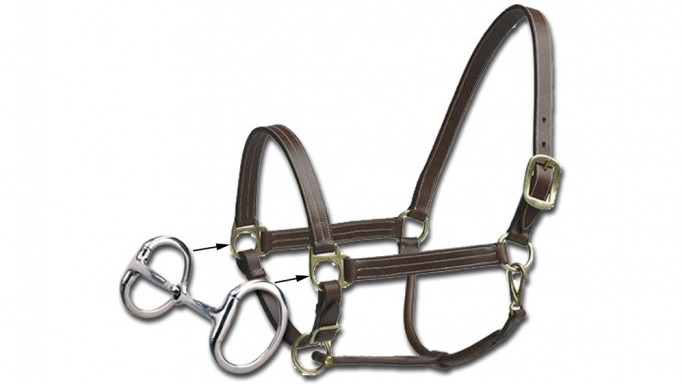“Bridles are introduced to our young stock as yearlings, because some of the breed organizations require you show them in hand in a snaffle bridle. If you introduce it early and do it the right way, it’s a total non-issue. Play with their mouths often, for instance, when you give them wormers, to get them used to having your fingers in their mouth. Always have your vet check their teeth and mouth first to make sure there are no problems before you proceed.
We introduce tack in a confined space – a stall where you can close the door is ideal. It shouldn’t have any obstructions; even screw eyes and buckets should be taken out so the youngster cannot get hung up if he gets nervous and tries to rub it off.
Have your equipment ready and adjusted properly – and give yourself enough time. Make sure everything is the right size for the age. Measure the mouth to make sure you have the right-sized bit. I’m a minimalist; you can’t go wrong with a fat snaffle. Once the bridle is on you don’t want to be fiddling with buckles. If it’s too tight, or sloppy on the head, they get fussy, and then you start fussing to adjust it and it’s counter-productive.
To start, we sometimes use a halter and attach a snaffle bit to it with quick-release snaps or something as simple as binder twine. Use a fat snaffle or rubber bit, something mild that won’t scare them. Let them work on that; you can still hold them with a lead rope attached to the halter so you don’t put any pressure on the bit. It’s very unobtrusive, and you can gauge right away if they’re going to fight it a little bit.
Some people use molasses on the bit – if your horse is very foodoriented, that might be a plan (we don’t do that). Once they are fine with the halter and mouthpiece after one or two sessions, they should be able to go straight into the bridle.
For first bridle lessons, you can leave the halter underneath so that you still have control with the lead rope without putting pressure on the bit. Take them for a walk down the aisle or in a small paddock.
You might go into the stall with the yearling, put the bridle on, walk him and have a little trot in hand – five minutes and you’re done. I’ve had others that will fight or be evasive, so you have to spend more time with them. Be patient – they all come around.
Getting a horse used to having something on its back can start even earlier. Our foals get little blankets on them, so they are used to straps and things. You can put a rope across the youngster’s back and tighten it a bit just to see what he will do, if he will be “goosey” or not. You can progress to adding a saddle pad with the rope over top. Even a six-month-old foal should be able to accept a rope over its back. Then when it comes time to put on the saddle, it has become second nature.
As a two-year-old, you can start to play with putting a saddle on and tightening the girth a bit (make sure you have the right-sized girth). We have old saddles kicking around that are especially for that purpose. You don’t want to strap your $5,000 saddle onto a youngster! They can react to it, rear up and fall over, so a confined area like a stall prevents a lot of that behaviour if they can’t back up and run away. Once they are calmly accepting it, walk them around the arena so they can get used to the feel of the saddle moving on their back.
Horses must get used to all kinds of things – some are more sensitive and take longer to get used to them. Take your time, do things in a controlled manner, and these early tack lessons should not be a big deal.”

